Bordered by the mighty Columbia River, Washington is home to many of the most significant Salmon runs in the lower 48 states. The Olympic Peninsula and Puget Sound are both strongholds for Salmon and Steelhead runs, making for incredible angling opportunities.

Numerous rivers pour off the Olympic and North Cascade Mountains, providing spawning habitat for Salmon. Additionally, tributaries to the Columbia River, including the extensive Snake and Salmon Rivers create a highway for Salmon through Washington, Oregon, and Idaho.
The ability to pursue and harvest Salmon in Washington is a highlight for local and visiting anglers alike. If you monitor the seasons, know the regulations, and have an arsenal of techniques, Salmon fishing in Washington can be very productive. And that’s why I’m here today…
Salmon Species in Washington
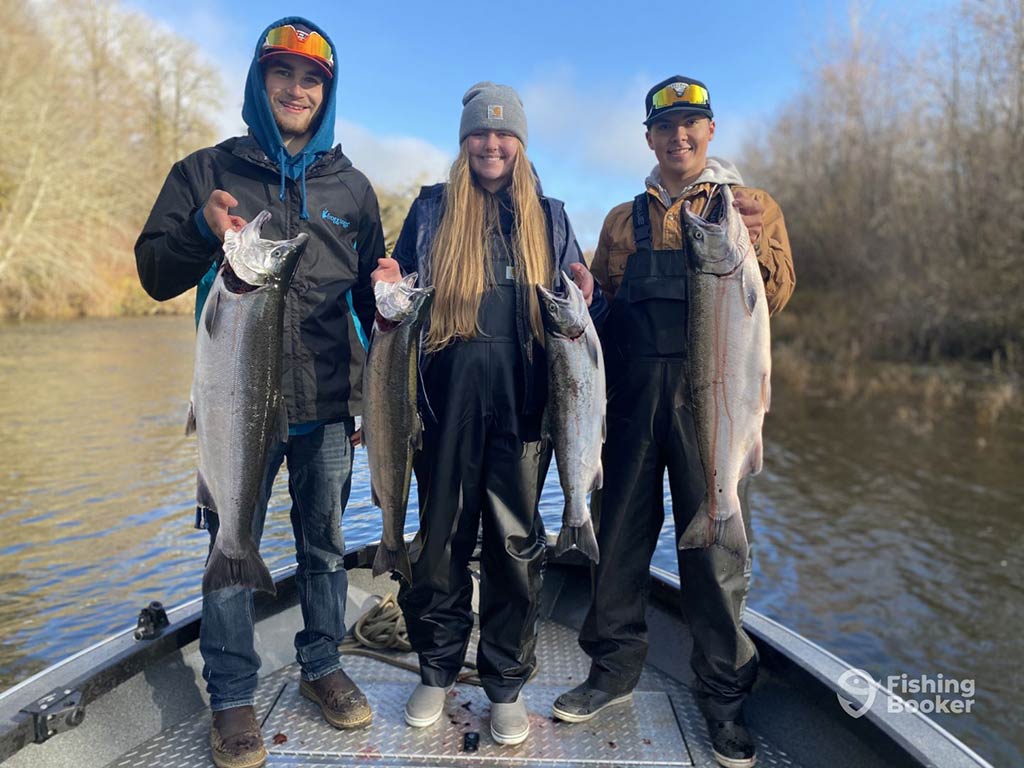
All five species of Salmon are present in the state of Washington with some being more reliable than others. They also act differently in terms of distribution while traveling to spawning grounds in river systems. Here they are:
Coho. Also known as Silver Salmon, these hard-fighting fish are often aggressive. They also make great table fare and are highly valued by recreational anglers in Washington. Silvers travel in schools and are available inshore and in river systems. The calm bays of Washington make it possible to pursue Silvers in motorized watercraft or by paddle boats like kayaks and canoes.
Chinook. The undisputed “King” of all Salmon species, Chinooks are also the largest. They fight like crazy, making blistering runs that test the limits of tackle and the breaking strength of lines. Available inshore and in the river systems, Chinook are prized for eating and for catch-and-release fishing. They’re tightly regulated and anglers should always be engaged and aware of limits, as they can change daily.
Pink. Often overlooked and underappreciated, Pink Salmon runs are abundant in odd-numbered years. They congregate in large schools in inshore fisheries and can quickly fill river systems bank-to-bank. They typically weigh several pounds and are hard fighting in saltwater and when fresh out of saltwater. But they do, however, deteriorate quickly in freshwater.
Chum. Like Pink Salmon, Chum are often underrated but there are some substantial runs in Washington. They also turn quickly in freshwater, but are particularly fantastic in saltwater and when only a few days out of them. Chum are powerful, hard fighting, and they make for decent table fare. Both Chum and Pink Salmon are ideal for smoking and canning.
Sockeye. Of all the Salmon species in Washington, Sockeye are the most revered for eating. Sockeye Salmon spawn in rivers that are connected to lake systems, and their fry depend on lakes for rearing. Landlocked Sockeye Salmon are referred to as “Kokanee” and are also available for anglers in the “Evergreen State.” Sockeye Salmon are available in a number of lakes and the Columbia River.
Salmon Fishing Season in Washington State
Salmon fishing in Washington is always in flux. Some years have very strong runs while others see down cycles. This means regulations are constantly changing and some individual fisheries even have catch limits that will shut down harvest for the season.
Salmon anglers in the state of Washington are highly engaged with the Washington Department of Fish and Wildlife. Keep the regulations to hand and check the current info for each individual body of water before fishing for Salmon.
Hatchery Salmon vs. Wild Salmon Regulations
There’s a clear distinction between hatchery and wild fish in Washington. Wild runs have tight regulations in terms of harvest, while hatchery runs offer more consistent opportunities. Anglers must learn the difference between these fish to ensure they are harvesting the correct type of fish.
Hatchery and wild fish overlap in some fisheries, creating confusion when harvest only applies to hatchery Salmon. Distinguish the fish by identifying the clipped adipose fin. Hatchery fish are clipped while wild fish have their adipose fin intact.
All Salmon anglers must carry catch cards to document their catch and harvest throughout the season. The cards must be returned to the state by April 30 following the season.
Washington Salmon Fishing Seasons
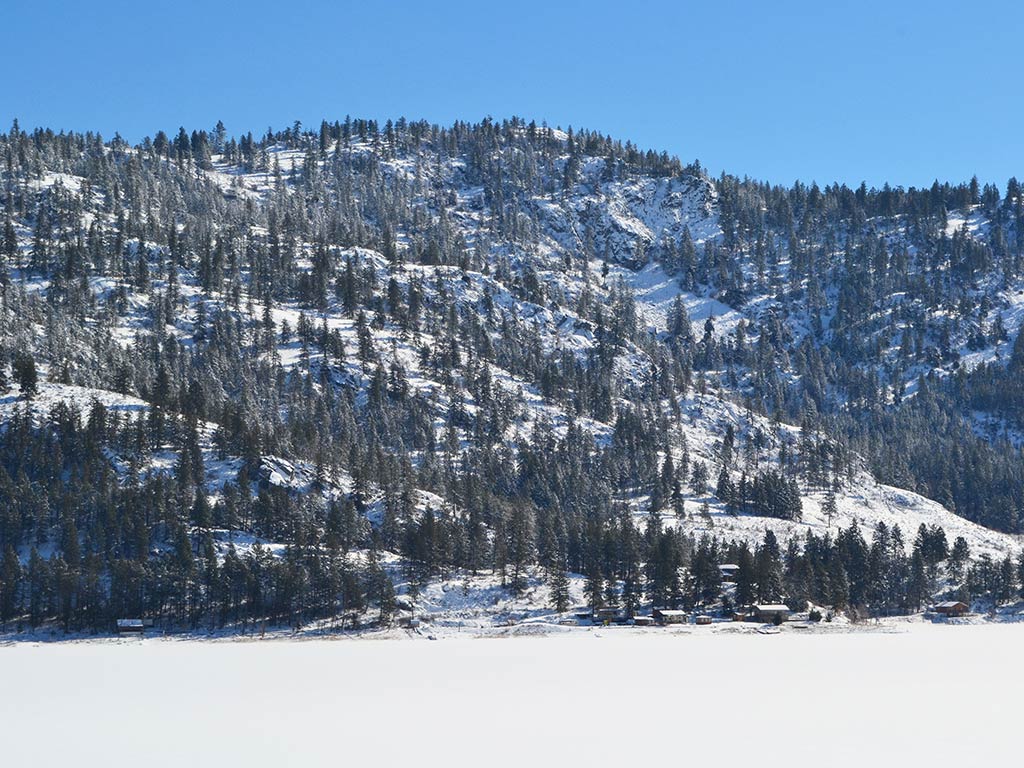
Use this as a general guide, knowing that legal definitions of seasons are always subject to change. This applies to the Puget Sound fishery and is also similar for the Columbia River runs. There are coastal systems and smaller runs that occur as outliers across the state, and these are listed in the official regulation booklets.
- Chinook Salmon. Some rivers experience a spring run in March or April but the primary season is June, July, and August with some carryover into early September.
- Coho Salmon. Summer and fall are the Coho seasons. July, August, and September are the prime months with some activity just before and after then.
- Sockeye Salmon. Sockeye is a summer-run fish with peak numbers occurring in July, August, and September. Run sizes vary from year to year and catch limits are often set based on returns.
- Pink Salmon. Remember, these runs occur in odd-numbered years. July and August is peak season with plenty of fish still in the rivers into September. Pinks can concentrate in specific river systems, as well.
- Chum Salmon. These runs tend to occur later in the year. You can see Chum in late summer with runs happening during July and August. However, the biggest numbers arrive in October, November, and December.
Where to Pursue Salmon in Washington
The options for Salmon fishing in Washington are overwhelming for those first researching the state. It helps to start with the big bays and primary fisheries. After grasping the geography, you can quickly expand to tributaries of the Puget Sound and Olympic Peninsula, as well as the Columbia and Cascade Rivers.
Inshore Fisheries
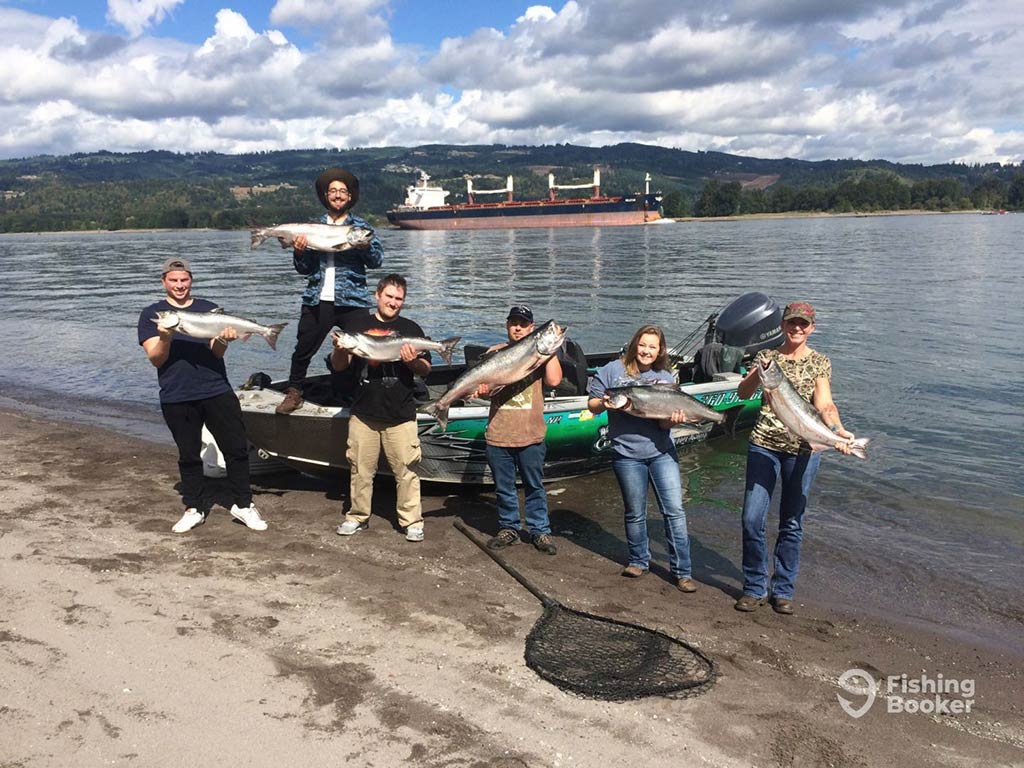
Salmon utilize nutrient bays in Washington and they congregate near river mouths before entering freshwater to spawn. Some of the bays are protected by islands and peninsulas, making them ideal for fishing without the presence of strong ocean currents.
The Mouth of Columbia River
The largest river system in Washington is the Columbia, and its mouth is a great place to find Salmon. Chinook and Coho are the most common sport fish for recreational anglers. Sockeye runs are also excellent in some years. This area is no secret and you’ll see plenty of other boats trolling and working the river mouth throughout the Salmon season(s). Just north, you can also find nearshore fisheries in places like Leadbetter Point, Westport, and Ocean Shores.
Puget Sound and Incorporated Coastal Rivers
Orcas and anglers like to troll the sound for Salmon. You can catch Coho and Chinook in this productive fishery throughout the summer. Chinook runs typically peak in August and Coho are present throughout the year. And Pink Salmon can also congregate in strong numbers.
The regulations incorporate a large geographical area for the sound and associated river systems. It extends from Olympia to Bellingham while also encompassing river systems around Port Angeles and the north ends of the Olympic Peninsula.
Outer Edge Olympic Peninsula Bays
Located outside the boundaries of Puget Sound is the outer edge of the Olympic Peninsula. It also sits north of the Columbia River mouth and the bays located just north of the river mouth region. La Push is a small coastal community central to the outer Olympic Peninsula.
The mouth of the Queets River defines the southern boundary of this region. Anglers can expect some stronger ocean currents in this region but the abundance of river mouths also makes it a good area to explore near-shore.
Productive Salmon Rivers in Washington
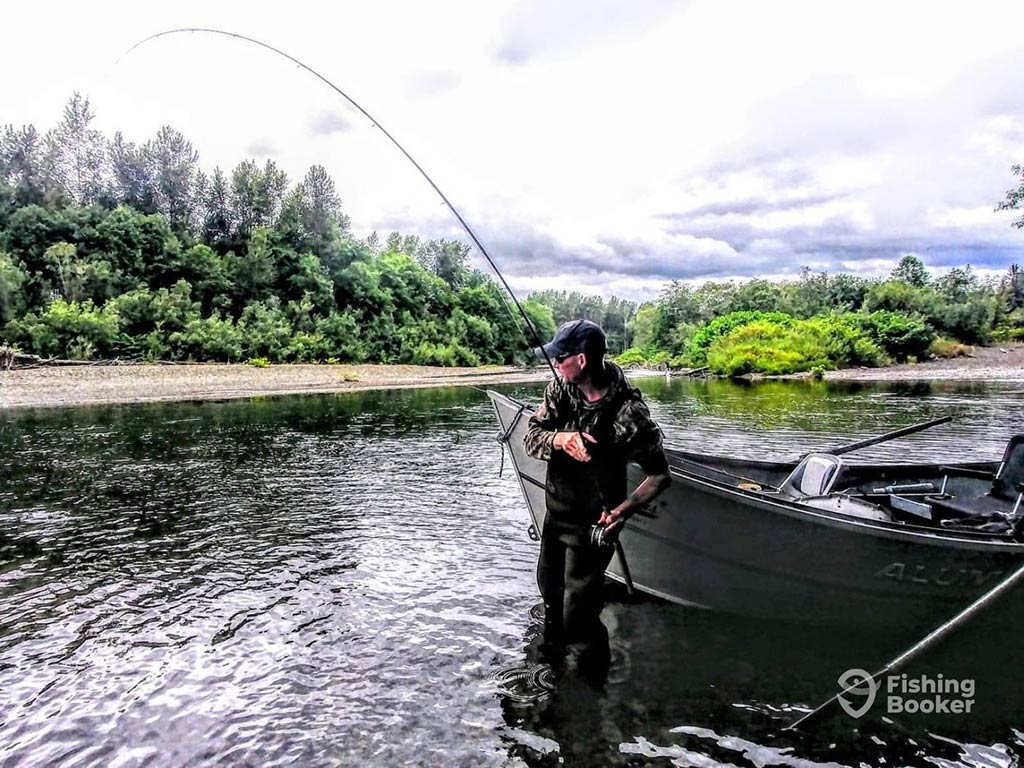
This is a small sampling of the river systems where Salmon runs are present. Always check the current regulations for fishing restrictions and catch limits for each individual river. In some instances, the regulations will even change between the mainstream of a river and its forks.
Puget Sound Fisheries
- Calawah River
- Chehalis River
- Dungeness River
- Elwha River
- Stillaguamish River
- Snoqualmie River
- Sol Duc
Columbia River Tributaries
- Chelan River
- Cispus River
- Cowlitz River
- Green River
- Kalama River
- Klickitat River
- White Salmon River
A note about the Snake River. A portion of the Snake River enters Washington State before joining the Columbia River. Downstream of the state boundary, you can fish for Salmon with a Washington fishing license. In the boundary waters area, an Idaho or Washington license is acceptable. After entering Idaho on the Snake or Clearwater River, you must transition to the Idaho fishing license and regulations.
Salmon Fishing Techniques
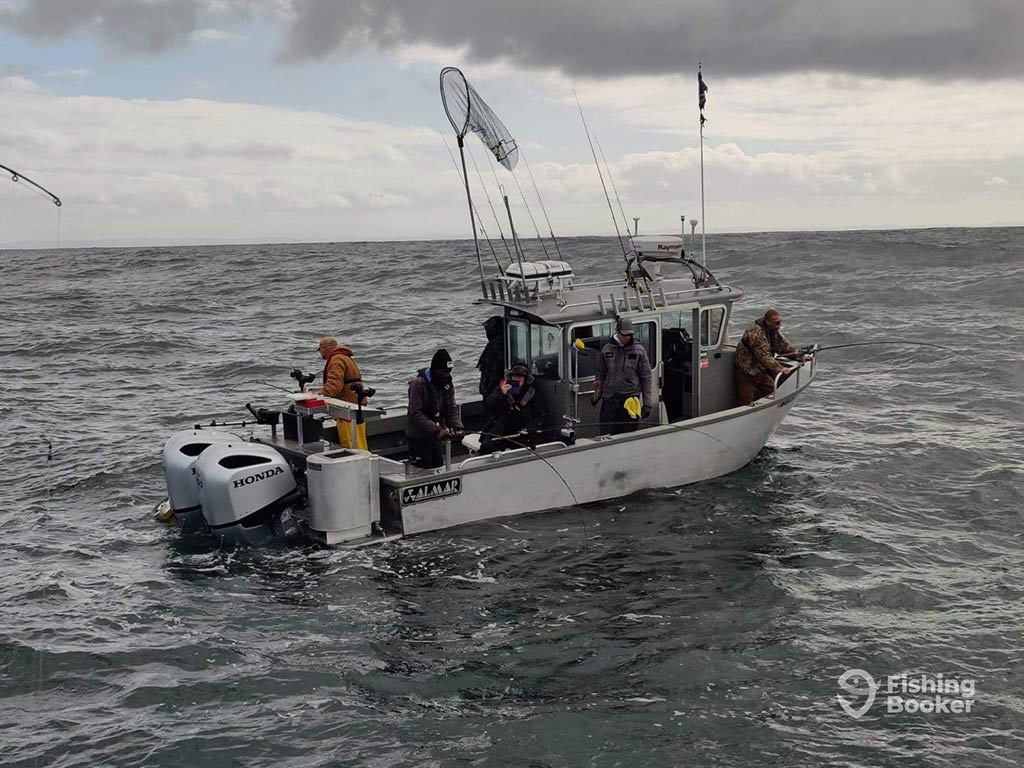
There are a ton of techniques that work for Salmon in the bays and rivers. Every angler has their own preferences based on conditions and timing in the run cycles. Artificial lures and flies work great as do various baits.
Trolling and Back Trolling
Trolling with a downrigger in the bay is a favorite technique. Boaters can set the right depth and cover ground while intercepting schools of Salmon. Bright flashers create high levels of visibility and pull Salmon into the lures and baits being trolled.
While trolling is a favorite technique in open waters, it also works in rivers. Back trolling uses rowing or motorized power to hold a boat in the current. Lures or baits are set downstream and also held by the force of the current. Salmon follow these currents and, if they’re present in the river, the odds of crossing their paths while trolling are high.
Casting Gear
Salmon are responsive to spoons, spinners, and a number of lure styles, making this style of fishing pretty simple. Casting from shore or a boat will get the job done when Salmon are present and active. You can catch Salmon with a cast and retrieve technique in both the bays and rivers.
Bouncing Egg Sacks
You can do this while back trolling or fishing from shore. Egg sacks have a high scent profile and are among the most effective means of catching Salmon. Using weights, cast into deep, slow pools and bounce the egg sacks along the bottom. When the bite is slow, this can trigger strikes from sluggish fish.
Jigging and Mooching
Mooching rigs with herring are very effective but many anglers also jig without bait. Marabou jigs with pink heads are excellent. The first trick is finding the fish and determining the best depth. Suspending the jig over schools of Salmon is ideal when fishing from a boat. This method also works from piers and jetties on occasion. Heavier jigs cast well and sink quickly, making them effective for bank anglers.
Fly Fishing
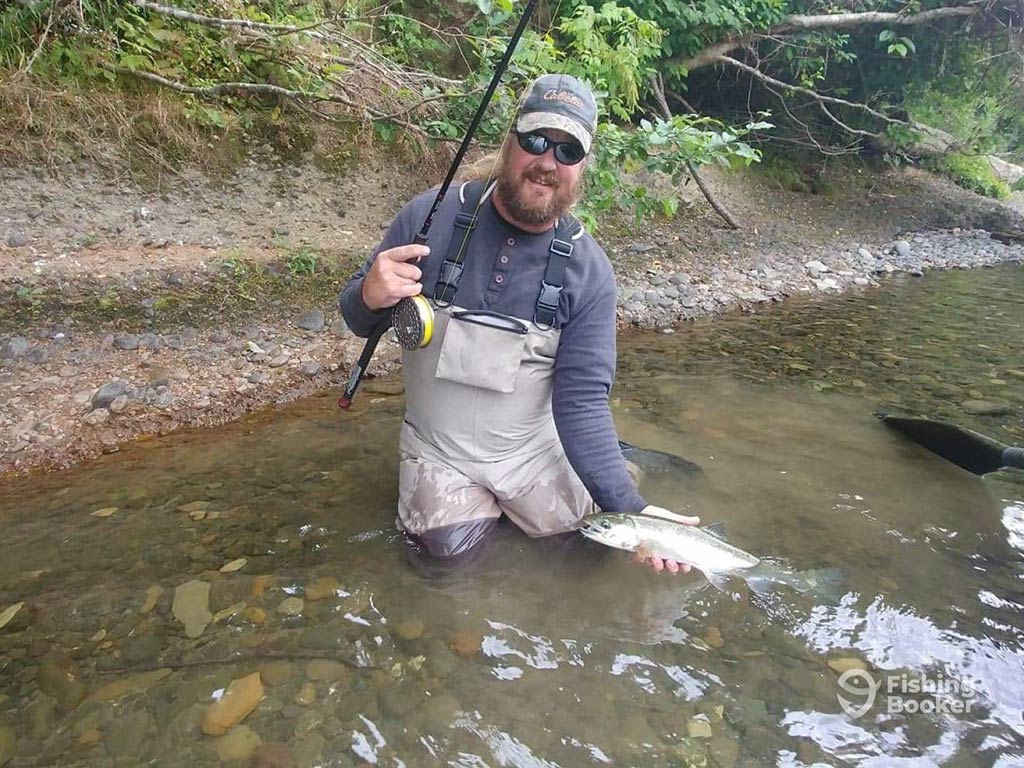
Fly anglers can cast with a single-hand or spey rod to catch Salmon. An 8 wt rod is the minimum for most Salmon species, while Chinook warrant a 10 wt rod. Bright-colored flies with pink, chartreuse, and purple are popular. Large intruder-style flies are effective for swinging. Fishing beneath a strike indicator with egg patterns and larger nymphs also works very well.
Will You Go Salmon Fishing in Washington?
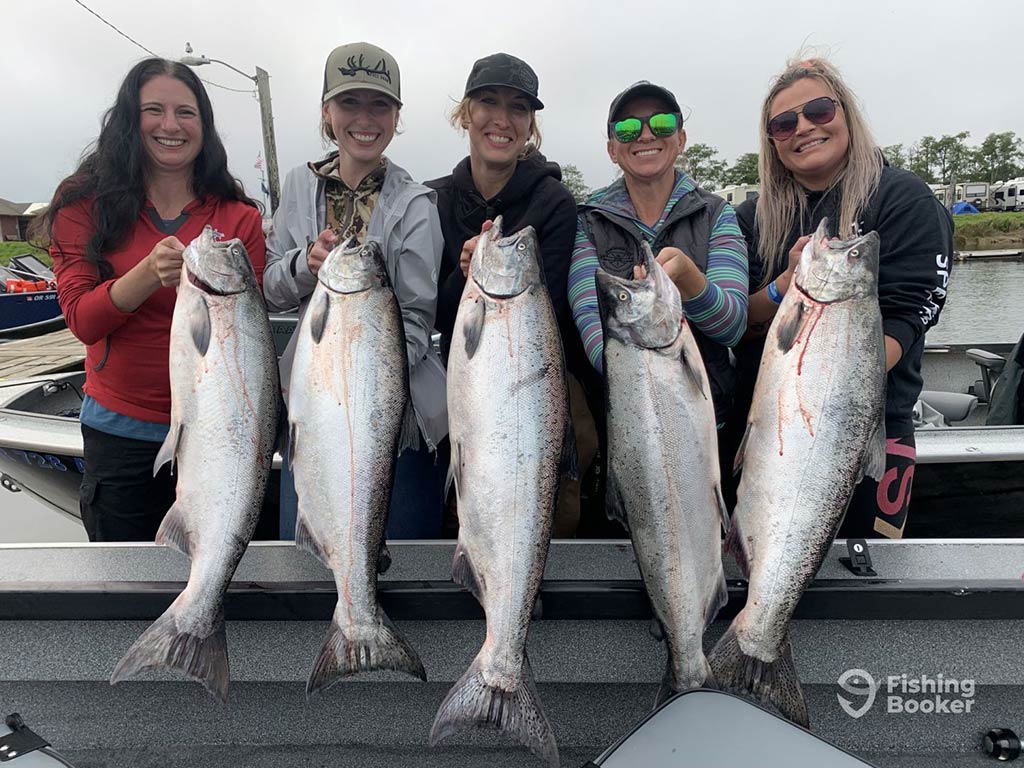
Short of traveling to Alaska, Washington State has some of the best Salmon fishing opportunities around. Oregon also has significant runs just to the south. Many of the fish passing through the Columbia River system will enter Oregon tributaries like the Deschutes River or Idaho Tributaries like the Salmon and Clearwater Rivers.
For inshore fishing opportunities, Puget Sound is hard to beat. The sheer number of rivers to explore also makes Washington an exciting place to chase all five species of Salmon. It’s now over to you to discover it for yourself.
Have you ever been Salmon fishing in Washington? Where did you find the most success? Any tips or tricks to share with your fellow anglers? Let us know in the comments below!
The post How to Go Salmon Fishing in Washington: An Angler’s Guide appeared first on FishingBooker Blog.
https://ift.tt/uaElI97
0 Comments
Enregistrer un commentaire